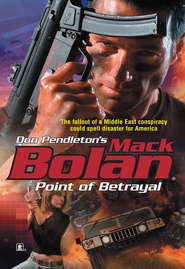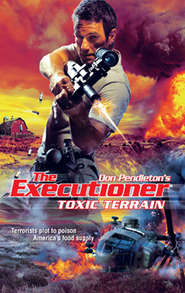По всем вопросам обращайтесь на: info@litportal.ru
(©) 2003-2025.
✖
Road Of Bones
Автор
Год написания книги
2019
Настройки чтения
Размер шрифта
Высота строк
Поля
Completely useless in a gunfight.
From the tall man’s look and his reaction to the shots, Bolan knew he was the inquisitor. Without a second thought, he raised the AKS and stitched the gawker with a rising burst from clavicle to forehead, shattering his face. The guy went down as if someone had cut his strings, and Bolan saw the woman in the chair turn toward him, blink, then look around to find out where the shots had come from.
Wondering if she was next?
The shooter behind the gravity wagon was playing it safe. His cohorts, flanking Bolan, did their best to keep it stealthy, but their style was obviously more attuned to smash-and-grab than creep-and-sneak. They telegraphed their moves with scuffling feet, letting their target track them in the dark.
Bolan fell back from the bright lights and climbed aboard a midsize Caterpillar tractor, crouching with his back against its open cab. He’d let the hunters come to him—the first of them, at least—and see what happened next.
The gunman coming from his left was faster, shuffling toward Bolan from behind a bale wrapper. He didn’t check the high ground, though, intent on peering under things, where shadows pooled. When he had closed the gap to twenty feet, a burst from Bolan’s SMG ripped into him and dropped him, twitching, on his back.
The dead guy’s backup took advantage of the muzzle-flash and banged away at Bolan with a pistol, but the Executioner was already in motion, airborne, dropping to a crouch behind the tractor as incoming rounds cracked through its cab.
The soldier broke to his left, keeping the bulk of the machine and its big engine block between his adversary and himself. When he was near the tractor’s nose, he knelt, then stretched prone and crawled around beneath the radiator grille, careful to keep his weapon’s magazine from scraping concrete as he went.
He caught the second shooter scrambling toward the tractor, pistol out in front of him and ready for a hasty shot if he was challenged. What he wasn’t ready for was half a dozen full-metal-jacket rounds slashing through his thighs and pelvis, spinning him into the line of fire and ending it with head shots.
Which left one.
Bolan emerged to find the last man standing with a pistol pressed against the naked woman’s head, half-crouched to use her as a human shield.
The soldier found a vantage point beyond the ring of light and stopped there, took a second to unfold his submachine gun’s stock and raise it to his shoulder. As stubby as it was, the little room-broom hadn’t been designed for sniping, but at forty feet he thought the shot was doable.
His weapon had a flip-up rear sight with a front cylindrical post. Its eight-inch barrel produced a muzzle velocity of 2400 feet per second, slower than the full-size AK-74, but an insignificant difference at what amounted to point-blank range.
While his target shouted, sounding more agitated by the moment, Bolan found his mark and held it—just above the guy’s left eyebrow, with the SMG’s selector set for semiauto fire. One shot, and if he missed it…
Crack!
A crimson halo wreathed the gunman’s head as he slumped over backward. Bolan thought the naked woman gasped but wasn’t sure. He crossed the open floor to reach her, opening a knife in transit. Keeping his eyes averted as he slit the duct tape at her wrists and ankles, he reached around to cut one side along her rib cage.
Finally, he met her eyes and saw the fear behind them. When she asked him something, Bolan couldn’t understand it.
“Slow down or speak English,” he suggested.
“Da. Yes. Who are you?”
“A friend, sent to get you.”
“Friend?” She didn’t seem to recognize the term.
He nodded. “We need to go. Do you have any clothes?”
“Shredded,” she told him, covering herself belatedly as best she could with slender arms. “They thought I wouldn’t need them…after.”
Bolan scanned the killing ground and saw a sport coat draped across a second chair, almost outside the ring of light. He collected it and passed it to the woman while he thought about the rest.
The man who’d used her as a shield was several inches taller than the woman, but he had a narrow waist. She’d have to roll the cuffs up on his slacks, but it could work if she cinched up his belt.
“You mind a pair of hand-me-downs?” he asked, his back turned as he began to strip the corpse.
“What do you…oh. No, those will do for now. My shoes are over here somewhere,” she told him, moving gingerly toward the rim of shadow. “With my bag, I think.”
Bolan kept his head turned as she came to get the slacks. When she was covered, buckling the dead man’s belt, she told him, “Don’t forget their guns.”
CHAPTER TWO
Japan, seven hours earlier
Bolan was in the middle of another operation when the call came. He’d been wreaking havoc on a drug pipeline, tracking the flow of heroin from Yakuza controllers through the Philippines, on to Hawaii, where it spilled into the veins of addicts.
He was up against the Yamaguchi-gumi, Japan’s most prosperous Yakuza Family and one of the world’s largest criminal organizations, with an estimated forty-five thousand oath-bound members and countless other close associates. Aside from heroin, the syndicate made billions annually from gambling, human trafficking and prostitution, internet pornography, extortion, gunrunning, stock fraud and labor racketeering.
It had been five days since he’d taken on the mission, and the Executioner was close to wrapping up his game. He’d taken out the clan’s first and second lieutenants, along with a couple dozen soldiers, and was planning a lethal surprise for the clan leader.
But then he got the call from home.
Drop everything and disengage, for now. We have a Level Four emergency.
Something in Russia, Hal Brognola told him, speaking guardedly despite the scrambled line. There was a job that absolutely couldn’t wait, lives hanging in the balance.
One life in particular.
How fast could he get from Kobe to Yakutsk in Sakha Republic? Bolan ran the calculation on his laptop while he had the big Fed on the line. His destination was located nineteen hundred miles northwest of Kobe, travel time dependent on how soon he booked a flight, the aircraft he obtained and when it could take off.
“Charter a plane ASAP,” Brognola had instructed him. “My dime. Call back when it’s arranged, and you’ll be met by someone from the Company. They’ll have the details and your basic kit. I’m sending through a file right now.”
Bolan opened his email, waited thirty seconds, then said, “Got it.”
“Good. I’m here until you call about the flight.”
The soldier cut the link and checked his watch. Eight-fifteen on a Saturday night in Kobe meant that it was 6:15 a.m. on Friday morning in Washington, D.C., thanks to the international date line. Brognola was a day and fourteen hours behind, but would be tracking the Russian event in real time.
Whatever it was.
Bolan booked his flight before reading the file. A charter company at Kobe Airport could put him aboard a Learjet 60 in two hours, if he had five grand and change to spare. Confirming that, Bolan was told the flight should take about four hours, which would put him on the ground in Yakutsk somewhere in the neighborhood of two-thirty to three o’clock on Sunday morning.
Fair enough.
He skimmed the file then, hitting the essentials, knowing there’d be ample time to study all its details in the air. Two agents of the FSB—Russia’s Federal Security Service, successor to the infamous KGB—had been collaborating with the CIA and Interpol to blow the whistle on a network of corruption that involved the upper echelons of government and commerce in the Russian Federation. The specifics weren’t provided, being strictly need-to-know, but Bolan got the picture.
There had always been corruption in the Soviet “worker’s paradise” under one-party rule, but the floodgates had opened with Communism’s collapse in 1991. Overnight, the world’s largest state-controlled economy was jostled into line with what some pundits liked to call the “Washington consensus,” adopting the alien concepts of liberalization and privatization.
The net result was economic chaos.
Liberalization meant eliminating price controls, which sparked hyperinflation and near-bankruptcy of Russian industry under President Boris Yeltsin. While Russia’s elderly and others living on fixed incomes watched their lifestyle go to hell, shady entrepreneurs and black marketeers spawned under Mikhail Gorbachev’s perestroika restructuring movement of 1985-90 rose to the top of the heap like scum on a stagnating pond. The Russian Mafia, formerly an underground network of thugs and swindlers, went public—then global—in an orgy of bribery, extortion and violence.
The result, inevitably, was a backlash of opposition, translated into widespread support for antireform candidates. Yeltsin’s campaign to Westernize Russia by fiat, including dissolution of Parliament in September 1993, sparked open rebellion in Moscow. While Spetsnaz troops stormed Parliament, killing 187 dissidents and wounding more than four hundred, separatists in the Chechen Republic were charting a course toward civil war and a new age of domestic terrorism.











